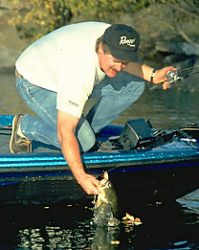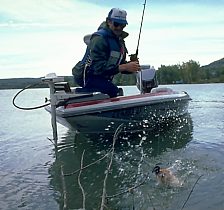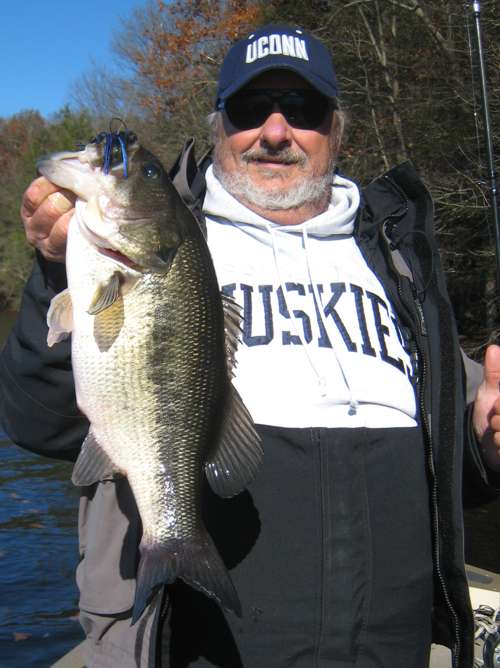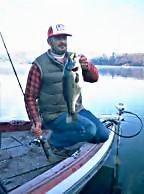From the time that the first inklings of the changing season begin to turn the leaves from green to yellow, red and brown, until ice arrives just a few short months later, virtually everything about the habitat of the typical, northern lake changes.  The most notable change is the fall turnover, during which oxygen depleted waters from the depths rise toward the surface, first causing an overall depletion of water quality in many of the areas frequented by the lake's bass population, and eventually, near uniformity of water chemistry and temperature throughout the lake's depths. But the cooling waters through this period have other effects on the habitat and its residents as well. The metabolic rate of the fish slows. Many life forms move into position for winter hibernation. And vegetation... often the key to bass location in natural lakes, falls back to winter subsistence levels. In short, the autumn-into-winter period is one of monumental and fairly rapid changes in the bass's world. The most notable change is the fall turnover, during which oxygen depleted waters from the depths rise toward the surface, first causing an overall depletion of water quality in many of the areas frequented by the lake's bass population, and eventually, near uniformity of water chemistry and temperature throughout the lake's depths. But the cooling waters through this period have other effects on the habitat and its residents as well. The metabolic rate of the fish slows. Many life forms move into position for winter hibernation. And vegetation... often the key to bass location in natural lakes, falls back to winter subsistence levels. In short, the autumn-into-winter period is one of monumental and fairly rapid changes in the bass's world.
For the most part, stable conditions are favored for bass fishing, and the fall is anything but... yet in the typical glacially formed natural lake, it's possible to view the fall's combination of rapid change and deteriorating habitat conditions as a positive factor, rather than a negative one.
The shallowest weeds are most affected by those first, sudden cold snaps that can cause water temperatures in the shallows to plummet as much as 10° overnight. Those shallow pad beds and such typically hold large quantities of forage. When the pads and matted milfoil beds begin to thin out and die off, bass often find a windfall feeding opportunity. And wherever and whenever bass take advantage of a windfall feeding situation, bass anglers can expect to find a windfall of their own.
This is the time to work along the inside edge of the remaining vegetation, just outside the areas where shallow cover is dying off. As the baitfish leave the thinning cover and move to the still dense deeper weedbeds, active bass will often cruise these weedlines and chow down. Depending on the type of cover present, and the density of that cover at the time this activity occurs, any of a variety of horizontally oriented lure presentations... from spinnerbaits and buzzbaits to lipless, rattling crankbaits, soft-stickbaits, or in some cases, even a pure topwater approach might turn the trick.
The best situation is often one in which only a few comparatively small patches of a hardier weed type exist adjacent to a large, shallow, pad-and/or-grass covered flat. This situation really concentrates the prey and the predators, and seems to accentuate the good fishing. Another situation that similarly concentrates the action in a smaller area and isn't to be overlooked is where a strip of harder bottom (which generally supports a hardier variety of vegetation than pads) extends into a pad bed. When the pads die off, you're left with a "point" along the new inside weedline, and fish will often be bunched along that point.
The fishing in this situation can be fast and furious, but it is usually short lived. A week or two is about all you can expect to get out of it on any given area, and it's not uncommon for it to start, peak, and die out in a matter of a few days. Obviously the severity of the change in conditions is a factor in how long this pattern lasts, but it's also dependent on exactly what conditions might be present in each environment. Different types of shallow cover diminish in different proportions in relation to the dropping temperatures for instance, and how well the next band of cover outside that first-to-die-off shallow vegetation holds up to the cold is equally important. If you're fishing a large lake with varied conditions, or if you have numerous smaller, simpler lakes to choose from, you can use this to your advantage, by identifying those lakes or areas within a larger lake that peak earlier and later, and fishing them in sequence, to extend the period of fast fishing over a longer time span.
One of my favorite patterns early in the fall is to fish the deeper inside weedlines in front of now-closed swimming beaches. I like to rely on a grub or small swimbait on a jighead or a drop shot rig in these areas, sitting outside the deep edge of the weeds, casting across the veggies onto the clean sandy bottom, then slowly swim or drag the offering until it contacts the base of the weeds on the inside weedline. I'm not 100% sure why, but I do markedly better with smaller, lighter presentations in this locational pattern than with heavier jig, spinnerbaits, etc.
While many anglers might bemoan a too-soon-end to the aggressive feeding that occurs when preyfish leave the dhallows, others view this period only as something to occupy their time while waiting for what they consider the real fall bonanza! As the fall progresses, a situation not too unlike the displacement of baitfish from the shallowest vegetation in the lake occurs on a much larger scale. The displacement of the bass themselves from the food shelf areas toward the lake's basin is what makes the late fall a special time of the year for many knowledgeable, serious big fish specialists.
What you're looking for in this situation is a fall-transition-break — the last well defined break or drop-off on the path from the vegetated shallows to the deep water area that serves as the cold-water-home for the lake's biggest bass. Once the water temperature gets into the 40s in the fall, most of the fish moving from the warm water feeding grounds to the deeper, more stable, cold water areas, pass through these transition break areas, and experienced, late-season lunker hunters note that the biggest fish seem most likely to linger around these spots the longest.
Precisely defining the conditions you're looking for can be difficult, because they are dependent on what options the available habitat offers. Once you're familiar with the kinds of things to look for though, it's surprisingly easy to identify it when you find it. Above all, the spot will offer a combination of elements in close proximity. The last remaining vegetation prior to ice-up; an "inside turn" (concave structural configuration); a steep drop (or series of steep drops and lips in a stair step arrangement) into deep water; hard bottom (gravel, sand, etc.); and large rocks (not necessarily boulders) are all attractive elements in the makeup of fall transition breaks in natural lakes. The more of these habitats features packed into a relatively small area, the better.
Of course the better the habitat in the transition break's adjoining food shelf area, the better the lunker possibilities. Areas with varied cover/depth/bottom composition options are long term homes to more fish, and consequently, the transition breaks associated with them are more heavily used.  It's been my experience that the absolutely ideal situation for big bass in a natural lake in mid-to-late fall is found when only one or two obvious, pronounced breaks exhibiting features similar to those described above exist in the transition area between deep, open water and a large food shelf of varied cover and depth, which also abuts a shallow, cover-rich bay or a long, fairly broad and equally cover-rich shallow point. Find a situation like this, and you've probably got a fall transition break that is used by a large number of fish. Sooner or later during the fall, many of them are going to cross, and likely linger, at the prime transition break. It's been my experience that the absolutely ideal situation for big bass in a natural lake in mid-to-late fall is found when only one or two obvious, pronounced breaks exhibiting features similar to those described above exist in the transition area between deep, open water and a large food shelf of varied cover and depth, which also abuts a shallow, cover-rich bay or a long, fairly broad and equally cover-rich shallow point. Find a situation like this, and you've probably got a fall transition break that is used by a large number of fish. Sooner or later during the fall, many of them are going to cross, and likely linger, at the prime transition break.
Like most true lunker oriented techniques, this seasonal opportunity does not usually offer fast action. It requires identifying, then "camping on" a spot with the right make-up, or rotating several such spots through the course of a day. You really have to rely on your ability to interpret the underwater terrain and conditions, recognize the prime spots, and then have faith that big fish will be there sooner or later. It follows then, that you must consider not only the conditions present at the transition spot itself, but the fish holding potential of the adjoining area when deciding where to invest your late fall fishing time. A combination of drop-off, bottom and cover elements that adds up to a seemingly perfect transition spot, but connects to a very limited food shelf area isn't likely to be as productive as a somewhat less ideal combination of transition break elements that connects to a more expansive flat or bay with more varied warm water season habitat options. The more fish the area can support in the summer, the more fish will be vacating it (and crossing any associated 'transition break') as winter approaches.
Once the early fall, shallow water blitz has passed, my natural lake fishing efforts usually revolve around the concept of picking two or three of the best late season transition spots I've identified in any given lake, and "parking" on each for periods ranging from a half hour or so to... well, in a few lakes that experience has proven to me have very good populations of lunker bass, I have been known to fish the same spot for the better part of the day. That's not really all that common an occurrence. More often, I'll fish several such spots, several times each. But there's no getting away from the fact that there are times when the patience to wait on the fish is a virtue.
As far as presentation and technique for big fish on the fall transition breaks is concerned, I will occasionally try a big, deep diving crankbait (the model being dependent on the depth range I consider "key" on a particular spot), and/or slow rolling a heavy spinnerbait across the area. But the bread and butter technique involves some type of slow moving, vertical presentation. And by vertical presentation, I don't mean that I'm fishing straight up and down under the rod tip, but fishing with a lure that is fished by allowing it to sink naturally to the bottom.  I rely on two opposite ends of the spectrum with my vertical presentation. At the small and light end, I go with a smoke grub on a 1/8 ounce jig head, or a drop shot rig with a motor oil worm. My worm of choice is typically a ringed style bai..t without an action tail. The other end of the vertical presentation spectrum, I go with what I call "The Big Jig". Three quarter ounce minimum, and 1 ounce is better. Tied with a big, extra full skirt (I actually usually use 2 extra full skirts most of the time). And I dress it with a big trailer. Time was, that combo was almost always a black, living rubber jig and brown #1 pork frog. But in recent years, the trailer will be a plastic chunk shaped like a pork frog, in a size that compares to a #1 or #10 pork frog. I use the big jig in green pumpkin/watermelon blend and in black with green highlights. The trailer will basically match the jig -- either green pumpkin or black. Plastic over pork in cold water? Absolutely. I've proven to myself enough times that pork has no special advantage in cold water, and plastic ALWAYS has better action and flotation. I rely on two opposite ends of the spectrum with my vertical presentation. At the small and light end, I go with a smoke grub on a 1/8 ounce jig head, or a drop shot rig with a motor oil worm. My worm of choice is typically a ringed style bai..t without an action tail. The other end of the vertical presentation spectrum, I go with what I call "The Big Jig". Three quarter ounce minimum, and 1 ounce is better. Tied with a big, extra full skirt (I actually usually use 2 extra full skirts most of the time). And I dress it with a big trailer. Time was, that combo was almost always a black, living rubber jig and brown #1 pork frog. But in recent years, the trailer will be a plastic chunk shaped like a pork frog, in a size that compares to a #1 or #10 pork frog. I use the big jig in green pumpkin/watermelon blend and in black with green highlights. The trailer will basically match the jig -- either green pumpkin or black. Plastic over pork in cold water? Absolutely. I've proven to myself enough times that pork has no special advantage in cold water, and plastic ALWAYS has better action and flotation.
I'll frequently throw a plain leadhead and plastic grub as an alternate, even when I'm thinking lunkers. In the late season, a 3" grub is often as likely to be bitten by a pig as a big jig and trailer.
I'm not big on a wide assortment of colors in any fishing situation, and even less so in the late fall/early winter. The crankbait I use will invariably be a baitfish inspired pattern like Tennessee shad.The spinnerbait, a nickel bladed single with a dark/light skirt combination (white/black, chartreuse/blue, etc.) and a black trailer.
I like to work the crankbait  across and slightly uphill but I prefer to work the jigs, grubs and the slow rolled spinnerbait downhill. It's definitely easier to maintain bottom contact dragging a lure uphill, but a sinking lure is often much more likely to get bit than a climbing one, and a downhill presentation facilitates this approach.
across and slightly uphill but I prefer to work the jigs, grubs and the slow rolled spinnerbait downhill. It's definitely easier to maintain bottom contact dragging a lure uphill, but a sinking lure is often much more likely to get bit than a climbing one, and a downhill presentation facilitates this approach.
As you tediously hop, scrape and drag your jigs or jump type lures across a spot, you should try to become completely familiar with every rock, every clump of remaining vegetation, every hollow or other variation in the contour. Eventually, you should be so familiar with the best spots that you have a mental, 3-D model of the spot at your disposal.
On many of my most productive fall transition spots, the vast majority of big fish come from one specific position... relating to one side of a particular rock, or holding in one certain clump of still green cabbage. I don't think any of us understands enough about the instincts and behavior of bass (especially lunker bass) to hazard a guess as to exactly why certain spots like that seem so much more attractive to them than nearly identical spots a few yards away. But two-decades-plus of fishing for big bass in the fall has left me absolutely convinced that there's "something" about certain spots that makes them big fish magnets.
The early fall blitz is great, and many natural lake anglers, happy to end their season on a high note, choose to skip the late fall transition. Fine. There are a lot of reasons to do so. It's not the fastest fishing of the year, the prime methods might best be described as tedious and the most productive days are often the most uncomfortable. Deer, quail and waterfowl offer attractive alternatives to late season fishing, too. But if you're among those anglers who finds satisfaction in fishing for that one big bite (or two, or three big bites for that matter) the likelihood of physical discomfort and long periods of using slow, methodical techniques between bites are a small price to pay, and alternative pursuits pale by comparison to a chance at the biggest bass of the season.
|